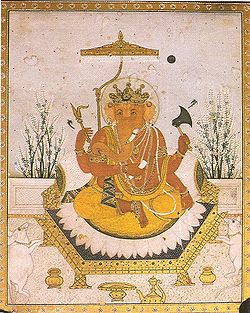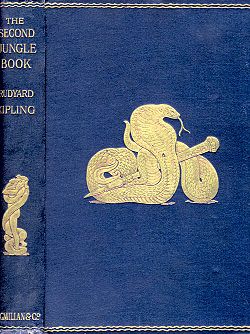
Ankus
Encyclopedia

Elephant
Elephants are large land mammals in two extant genera of the family Elephantidae: Elephas and Loxodonta, with the third genus Mammuthus extinct...
s, the largest land animals. It consists of a hook (usually bronze or steel) which is attached to a 60 - 90 cm (two- or three-foot) handle. The hook is inserted into the elephant's sensitive skin, either slightly or more deeply, to cause pain and induce the elephant to behave in a certain manner.
A relief at Sanchi
Sanchi
Sanchi is a small village in Raisen District of the state of Madhya Pradesh, India, it is located 46 km north east of Bhopal, and 10 km from Besnagar and Vidisha in the central part of the state of Madhya Pradesh. It is the location of several Buddhist monuments dating from the 3rd...
and a fresco at the Ajanta Caves depict a three person crew on the war elephant, the driver with an elephant goad, what appears to be a noble warrior behind the driver and another attendant on the posterior of the elephant.
Nossov and Dennis (2008: p. 19) report that two elephant goads, perfectly preserved were recovered from an archaeological site at Taxila
Taxila
Taxila is a Tehsil in the Rawalpindi District of Punjab province of Pakistan. It is an important archaeological site.Taxila is situated about northwest of Islamabad Capital Territory and Rawalpindi in Panjab; just off the Grand Trunk Road...
and are dated from 3rd century BCE to the 1st century CE according to Marshall
John Marshall (archaeologist)
Sir John Hubert Marshall was the Director-General of the Archaeological Survey of India from 1902 to 1928...
. The larger of the two is 65 cm long.
Nossov and Dennis (2008: p. 16) state:
An ankusha, a sharpened goad with a pointed hook, was the main tool for managing an elephant. The ankusha first appeared in India in the 6th-5th century BC and has been used ever since, not only there, but wherever elephants served man.
Fabrication and construction
The handle can be made of any material, from wood to ivory, depending on the wealth and opulence of the owner. Contemporary bullhooks which are used for animal handling generally have handles made of fibreglass, metal, plastic, or wood.The elephant goad is found in armouries and temples all across India
India
India , officially the Republic of India , is a country in South Asia. It is the seventh-largest country by geographical area, the second-most populous country with over 1.2 billion people, and the most populous democracy in the world...
, where elephants march in religious processions and perform in various civil capacities. They are often quite ornate, being decorated with gemstones and engravings to be appropriate for the ceremonies in which they are used.
Literature

Rudyard Kipling
Joseph Rudyard Kipling was an English poet, short-story writer, and novelist chiefly remembered for his celebration of British imperialism, tales and poems of British soldiers in India, and his tales for children. Kipling received the 1907 Nobel Prize for Literature...
's Second Jungle Book
The Second Jungle Book
The Second Jungle Book is a sequel to The Jungle Book by Rudyard Kipling. First published in 1895, it features five stories about Mowgli and three unrelated stories, all but one set in India, most of which Kipling wrote while living in Vermont...
story "The King's Ankus", Mowgli
Mowgli
Mowgli is a fictional character from India who originally appeared in Rudyard Kipling's short story "In the Rukh" and then went on to become the most prominent and memorable character in his fantasies, The Jungle Book and The Second Jungle Book , which also featured stories about other...
finds the magnificently-jeweled elephant goad of the title in a hidden treasure chamber. Not realizing the value men place on jewels, he later casually discards it in the jungle, unwittingly leading to a chain of greed and murder amongst those who find it after him.
Iconography
The elephant goad is a polysemic iconographic ritual tool in HinduismHinduism
Hinduism is the predominant and indigenous religious tradition of the Indian Subcontinent. Hinduism is known to its followers as , amongst many other expressions...
, Jainism
Jainism
Jainism is an Indian religion that prescribes a path of non-violence towards all living beings. Its philosophy and practice emphasize the necessity of self-effort to move the soul towards divine consciousness and liberation. Any soul that has conquered its own inner enemies and achieved the state...
and Buddhism
Buddhism
Buddhism is a religion and philosophy encompassing a variety of traditions, beliefs and practices, largely based on teachings attributed to Siddhartha Gautama, commonly known as the Buddha . The Buddha lived and taught in the northeastern Indian subcontinent some time between the 6th and 4th...
, in the inclusive rubric
Rubric
A rubric is a word or section of text which is traditionally written or printed in red ink to highlight it. The word derives from the , meaning red ochre or red chalk, and originates in Medieval illuminated manuscripts from the 13th century or earlier...
of Dharmic Traditions.
The elephant has appeared in cultures across the world. They are a symbol of wisdom in Asian cultures and are famed for their memory and intelligence, where they are thought to be on par with cetaceans and hominids. Aristotle
Aristotle
Aristotle was a Greek philosopher and polymath, a student of Plato and teacher of Alexander the Great. His writings cover many subjects, including physics, metaphysics, poetry, theater, music, logic, rhetoric, linguistics, politics, government, ethics, biology, and zoology...
once said the elephant was "the beast which passeth all others in wit and mind". The word "elephant" has its origins in the Greek , meaning "ivory" or "elephant".
In iconography and ceremonial ritual tools, the elephant goad is often included in a hybridized tool, for example one that includes elements of Vajrakila, 'hooked knife' or 'skin flail' (Tibetan: gri-gug, Sanskrit: kartika), Vajra
Vajra
Vajra is a Sanskrit word meaning both thunderbolt and diamond...
and Axe, as well as the goad functionality for example. Ritual Ankusha were often finely wrought of precious metals and even fabricated from ivory
Ivory
Ivory is a term for dentine, which constitutes the bulk of the teeth and tusks of animals, when used as a material for art or manufacturing. Ivory has been important since ancient times for making a range of items, from ivory carvings to false teeth, fans, dominoes, joint tubes, piano keys and...
, often encrusted with jewels. In Dharmic Traditions the goad/ankusha and rope 'noose/snare/lasso' (Sanskrit: Pāśa) are traditionally paired as tools of subjugation.
Hinduism
In the Hinduism, an elephant goad is one of the eight auspicious objects known as Astamangala and certain other religions of the Indian subcontinentIndian subcontinent
The Indian subcontinent, also Indian Subcontinent, Indo-Pak Subcontinent or South Asian Subcontinent is a region of the Asian continent on the Indian tectonic plate from the Hindu Kush or Hindu Koh, Himalayas and including the Kuen Lun and Karakoram ranges, forming a land mass which extends...
. A goad is also an attribute of many Hindu gods, including Ganesha
Ganesha
Ganesha , also spelled Ganesa or Ganesh, also known as Ganapati , Vinayaka , and Pillaiyar , is one of the deities best-known and most widely worshipped in the Hindu pantheon. His image is found throughout India and Nepal. Hindu sects worship him regardless of affiliations...
.
Buddhism
WallaceB. Alan Wallace
B. Alan Wallace is an American author, translator, teacher, researcher, interpreter, and Buddhist practitioner interested in the intersections of consciousness studies and scientific disciplines such as psychology, cognitive neuroscience, and physics...
and Goleman
Daniel Goleman
Daniel Jay Goleman is an author, psychologist, and science journalist. For twelve years, he wrote for The New York Times, specializing in psychology and brain sciences. He is the author of more than 10 books on psychology, education, science, and leadership.-Life:Goleman was born in Stockton,...
(2006: p. 79) discuss 'śamatha
Samatha
Samatha , śamatha "calm abiding," comprises a suite, type or style of Buddhist meditation or concentration practices designed to enhance sustained voluntary attention, and culminates in an attention that can be sustained effortlessly for hours on end...
' (Sanskrit), mindfulness and introspection
Introspection
Introspection is the self-observation and reporting of conscious inner thoughts, desires and sensations. It is a conscious and purposive process relying on thinking, reasoning, and examining one's own thoughts, feelings, and, in more spiritual cases, one's soul...
which they tie to metacognition
Metacognition
Metacognition is defined as "cognition about cognition", or "knowing about knowing." It can take many forms; it includes knowledge about when and how to use particular strategies for learning or for problem solving...
:
Throughout Buddhist literature, the training in shamatha is often likened to training a wild elephant, and the two primary instruments for this are the tether of mindfulness and the goad of introspection.
Rowlands (2001: p. 124) in discussing consciousness and its self-conscious, self-reflexive quality of apperception
Apperception
Apperception is any of several aspects of perception and consciousness in such fields as psychology, philosophy and epistemology.-Meaning in psychology:...
states that:
The most significant aspect of consciousness, I shall try to show, is its structure, its hybrid character. Consciousness can be both act and object of experience. Using the somewhat metaphorical notion of directing, we might say that consciousness is not only the directing of awareness but can be that upon which awareness is directed. Consciousness is not only the act of conscious experience, it can be experience's object. [italics preserved from original]
In the above quotation the metaphor of 'directing' is employed. In 'directing' consciousness or the mind to introspectively apperceive the directive forded by the goad is key.

